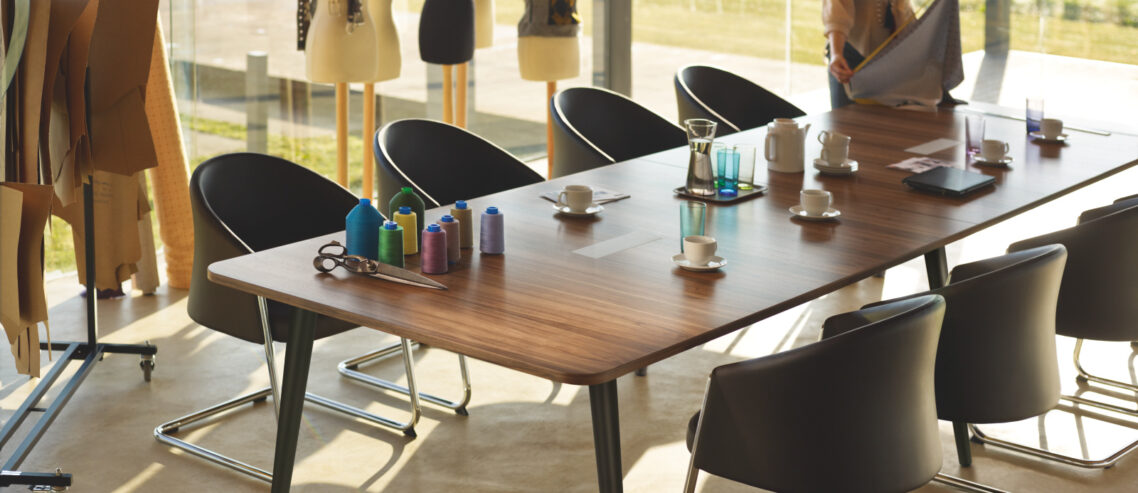What Does Your Conference Table Say About Your Business?
Tables have been around since the 3rd millennium BCE, according to the historical records of ancient Egyptians, Mesopotamians, and Chinese.1 And before that, we think it’s safe to say that many rocks were used as tables, and maybe a tree trunk or two.
Along the way, tables became more valuable in certain settings for signaling status than for performing their basic functions. Eventually, as the era of corporations blossomed, conference tables became a worldwide office staple. Let’s dive into the details of modern conference tables and how to choose the right one.
What are conference tables used for?
The conference table, in general, is the place where organizations, groups, and individuals go to collaborate. Designers have combined many shapes, sizes, materials, and features to satisfy the many demands a company can put on an office table.
Boardroom tables are the pinnacle of the conference table. This is traditionally where executives, members of the board, or investors meet. They used to have one style: long, rectangular, and imposing. No matter the shape, however, the most important person sits at the focal point, usually the “head” of the table. Other boardroom furniture includes sturdy and comfortable chairs suitable for meetings that extend for hours at a time.
Modern conference tables aren’t only for executives; individuals and teams use them for collaborative efforts. Many modern businesses increasingly prefer round, square, U-shaped, or V-shaped tables. These designs help everyone feel equal, encouraging greater participation.
The modern conference table is used for various activities — interviews, business lunches, seminars, training, meetings, brainstorming, or even just co-working. They’re multi-functional and usually free of any clutter or materials that hinder productivity.
What should I look for in a conference table?
First, ask questions about the kinds of meetings, conferences, or presentations that will happen in the room. The answers will help you determine what kind of conference table is right for your office.
Size
The size of the table must be considered in relation to the size of the room. You want plenty of space surrounding the table for chairs to slide in and out comfortably. People seated at the conference table should be able to stand up and sit down easily. Other attendees should also be able to walk around and behind seated individuals. If your table is in a multi-functional office environment, you may consider meeting room tables that fold and store easily.
Price
Any company or individual looking to buy a conference table should set a budget before starting their search. The table isn’t the only factor in your budget, especially when setting up a new conference room. Consider whether you’ll also have to buy chairs, TVs, microphones, or other amenities as you set a firm budget.
Shape
The traditional conference room table is long rectangle and typically reserves a seat at the end for an important individual. You’ll often see these in boardrooms, too. However, modern offices have adapted to more team-based and casual work environments. People now choose round, V-shaped, U-shaped, or square tables to encourage equal participation from those in attendance. How do you expect people to communicate while they use it? Think about what message you want to send with the shape of your conference room table.
Material
Older conference room tables were usually made of solid wood. Manufacturers evolved to satisfy various trends by using glass, steel, stone, plastic laminate, veneers, and other materials. While solid wood is the most timeless choice, there are many reasons to consider alternatives. They can be more durable, modern, affordable, and easier to clean.
Quality
The quality of the meeting room furniture you choose will affect the price. But that furniture will say something about your company to guests and employees. And you do not want it to fall apart and look shabby. Will the conference room table be used every day? What kinds of activities do you expect people to be doing there? Will it ever come in contact with food and drinks? Consider how much wear and tear the meeting table will experience in a week. A high-quality meeting room table that lasts might be less expensive than two tables that wear out.
Style
Ideally, the table will fit and enhance the overall style of the entire office. Many newer companies opt for simpler, streamlined solutions that can adapt and transform as needed. These tables tend to be lightweight, made of durable materials and show clean lines and neutral colors. They are ideal for rooms with natural sunlight. But that’s not everyone’s cup of tea. Some offices opt for heavier, solid materials because of their durability, longevity, and timeless style. It’s all about the message you want your office style to send to everyone who walks through its doors.
Amenities
In the past decade, we’ve seen an explosion of technology that businesses can use, particularly when it comes to meetings. When many of our meeting spaces went virtual in 2020, we plunged into the world of virtual team collaboration. This changed the amenities we expect in meeting rooms, such as digital AV solutions for remote workers or clients. But it also changed the specifications for meeting tables, which now can include integrated power outlets, microphones and other electronics. Consider what amenities would be beneficial for your business.
Choosing the right conference table
When choosing a conference table to suit all your company’s needs, consider Sedus. Established in 1871, Sedus Stoll AG is now one of the leading European office furniture manufacturers. With unmatched innovation and quality, they can help you find the right conference room table for your business. Contact Sedus to see how they can provide you with customized office furniture solutions today.
1 How Did Tables Evolve as Furniture
